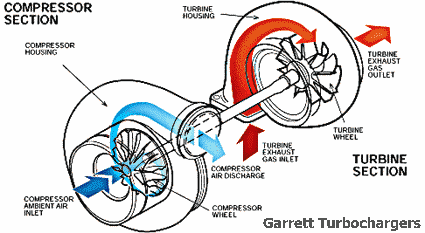
| Attention manufacturers, modifyers, and owners of turbochargers for the Mitsubishi 3000GT and Dodge Stealth. This web page is the most popular one at my web site. It gets over 100 hits every day. Please contact me regarding any incorrect or incomplete information here for your turbos. Also, have a turbo not listed here? Send an email to website at stealth316 dot com with complete specs and additional information as presented below and I'll consider adding it to this web page. |
Introduction
Before spending thousands of dollars on turbo and associated upgrades, I recommend spending $35 on Corky Bell's book Maximum Boost. This is the definitive book on turbocharging. Other books that are very helpful are Turbochargers by Hugh MacInnes ($18) and Motorcycle Turbocharging, Supercharging, and Nitrous Oxide by Joe Haile ($20). The magazine Sport Compact Car ran an excellent series of articles about turbos in the following issues: July 2001, August 2001, September 2001, October 2001, and July 2002. For an excellent explanation of the turbocharger and intercooler setup on the Stealth/3000GT cars, take a look at Roger Gerl's web page http://www.rtec.ch/turbo_basics.html. My Pressurization Primer presents a quick review of the processes and controls involved in pressurizing the intake plenum and manifold. My web page 2-3s-compflowmaps.htm explains how to read and interpret compressor flow maps.
Performance Criteria
When selecting a turbocharger for the 3000GT/Stealth, especially if the turbo is a hybrid or not built by the manufacturer of the turbo components, the following items should be considered.| Maximum Effective Volume Airflow in CFM - 6 cyl (3 cyl) 2.972 L V6 @ 100% VE, constant temp., 14 psi into turbo |
||||||
| RPM | 0 psi boost | 10 psi boost | 15 psi boost | 20 psi boost | 25 psi boost | 30 psi boost |
|---|---|---|---|---|---|---|
| 2000 | 105 (52) | 180 (90) | 217 (109) | 255 (127) | 292 (146) | 330 (165) |
| 3000 | 157 (79) | 270 (135) | 326 (163) | 382 (191) | 438 (219) | 495 (248) |
| 4000 | 210 (105) | 360 (180) | 435 (218) | 510 (255) | 585 (293) | 660 (330) |
| 5000 | 262 (131) | 450 (225) | 543 (272) | 637 (319) | 731 (366) | 825 (413) |
| 6000 | 315 (158) | 540 (270) | 652 (326) | 764 (382) | 877 (439) | 990 (495) |
| 7000 | 367 (184) | 630 (315) | 761 (381) | 892 (446) | 1023 (512) | 1155 (578) |
| 8000 | 420 (210) | 719 (360) | 869 (435) | 1019 (510) | 1169 (585) | 1318 (659) |
| Modified Engine Effective Volume Airflow in CFM - 6 cyl (3 cyl) 2.972 L V6, constant temp., 14 psi into turbo |
|||||||
| RPM | VE | 0 psi boost | 10 psi boost | 15 psi boost | 20 psi boost | 25 psi boost | 30 psi boost |
|---|---|---|---|---|---|---|---|
| 2000 | 87% | 91 (46) | 157 (78) | 189 (94) | 222 (111) | 254 (127) | 287 (144) |
| 3000 | 88% | 138 (69) | 238 (119) | 287 (143) | 336 (168) | 385 (193) | 436 (218) |
| 4000 | 93% | 195 (98) | 335 (167) | 405 (202) | 474 (237) | 544 (272) | 614 (307) |
| 5000 | 96% | 252 (126) | 432 (216) | 521 (260) | 612 (306) | 702 (351) | 792 (396) |
| 6000 | 94% | 296 (148) | 508 (254) | 613 (306) | 718 (359) | 824 (412) | 931 (465) |
| 7000 | 90% | 330 (165) | 567 (284) | 685 (342) | 803 (401) | 921 (460) | 1040 (520) |
| 8000 | 85% | 357 (179) | 611 (306) | 739 (370) | 866 (433) | 994 (497) | 1120 (560) |
MHI Turbo Nomenclature
Mitsubishi Heavy Industries' (MHI) turbocharger nomenclature, such as TD04-13G-6cm2, requires some explanation. "TD04" and "TD05" refer to the turbocharger housing (either turbine housing or compressor housing or both), including the center housing (or CHRA or cartridge section). There are different styles of the basic housings and these have different suffixes appended to the basic designation, such as TD04L, TD04H, TD04HL, TD05, TD05H, and TD05HR.Ball-Bearing Turbos
Conventional turbos, including all MHI TD04 and TD05 turbos, use sleeved journal bearings in the CHRA to support and protect the rotating shaft and to provide resistance to thrust loading. The bearings must carefully position the turbine and compressor wheels very close to the contours in their respective housings at speeds over 100,000 RPM. Oil from the engine is used as a lubricant to reduce friction on the bearing surfaces and to cool the CHRA. Various seal systems are used to prevent the oil from entering the turbine and compressor housings and to reduce the flow of exhaust gas and compressed air into the CHRA. Very often (and in all MHI TD04 and TD05 turbos), engine coolant circulates in a jacket through the CHRA to provide additional cooling. The maximum recommended operating temperature (maximum exhaust gas temperature) of nearly all turbos is 950ºC (1742ºF).Available Turbos
Other than the model name, there is often little other information available except for the rated CFM flow at 15 psi or 2.0 pressure ratio. Very often the manufacturer of a custom turbo is protective of its design. Fortunately, other information can be estimated solely from the rated flow number. The surge point at 15 psi is often about 1/4 the value of the rated flow. For some designs, such as the T04E "60", the surge point is closer to 1/3 the rated flow. For the IHI ball-bearing turbos, the surge limit is about 13 to 18 percent of the rated flow. Turbos that are a size appropriate for our engines usually have a maximum pressure ratio of 2.8 to 3.1 (or 26.5 to 31 psi boost at sea level before pressure losses in the intercooler system). Also, the CFM flow where a wide range of pressure ratios, from 1.7 to 2.7 (10 to 25 psi boost before IC pressure losses), is available is somewhat less than the rated flow at 15 psi. This practical "maximum" CFM flow is usually about 90 to 95 percent of the rated flow. The choke flow is the maximum amount of volume flow the turbo can produce at any pressure ratio.| Turbochargers Available for the Mitsubishi 3000GT/Dodge Stealth | |||||||
|---|---|---|---|---|---|---|---|
| Name | Min CFM @2.0 PR |
Rated CFM @2.0 PR |
Practical Max CFM |
Choke Flow CFM |
Compr. Flow Map |
Source | Comments |
| Stock manifolds retained | |||||||
| TD04-09B-6cm2 | 80 | 275 | 250 | 280 | MHI | - stock on USA VR-4 and TT - right-side number: 49177-02310 or 49177-02300 - left-side number: 49177-02410 or 49177-02400 - cartridge number: 49377-08020 - turbine and shaft: 49177-30130 - repair kit number: 49177-80400 - rotor is 1.57"/1.86" (TD04) |
|
| TD04-13G-6cm2 | 90 | 360 | 324 | 375 | MHI | - stock on European and maybe Japanese VR-4 - aka: Mitsubishi Sport Turbo - right-side number: 49177-00320 - left-side number: 49177-00420 - cartridge number: 49377-08040 - repair kit number: 49177-80400 - 1989-1994 Eclipse 4G63 2.0L Automatics had TD04-13G-5cm2 (turbo 49177-01901 with cartidge 49177-09010) - rotor blade length is 5 mm - rotor is 1.62"/1.86" (TD04L) |
|
| GT347 | 93 | 370 | 330 | GTP | - GTP does not release compressor information - Basically a "13G-class" turbo - Mitsu TE04H 13C compressor wheel - TD04 turbine housing and center section - Just a guess at CFM |
||
| GT357 Magnum | 120 | 400 | 350 | 405 | GTP | - GTP does not release compressor information - Basically a "15G-class" turbo - Garrett T3 "50" Trim compressor wheel - TD04 housings and center section - GTP claims 480 CFM rated flow, but the compressor wheel size suggests a flow rating of about 400 CFM - Garrett flow map numbers shown for T3 "50" Trim - TE04 turbine wheel |
|
| TD04-13T-6cm2 | ~106 | ~428 | ~405 | ~445 | VAR | - Flow is similar to the 15G and 15C - This is a hybrid turbo with flow characteristics varying depending on the manufacturer - Subaru WRX 13T compressor housing - Bored TD04-9B turbine housing with 13T TD04L wheel - Turbine inducer blade length is 6 mm - Requires modifications: - to turbocharge housings - wastegate relocation brackets with extension bosses - adapt IC pipe to rear turbo - notch out of upper intake support bracket near rear turbo - Rob Beck manufactures these hybrids; for more info see http://www.3si.org/forum/showthread.php?t=228909 |
|
| TD04-15G-6cm2 | 106 | 428 | 405 | 445 | TEC VAR |
- This is a hybrid turbo with flow characteristics varying depending on the manufacturer - TD04H flow map numbers shown - Actual flow rating may be closer to 400 cfm for some examples - on-car performance depends on rotor used |
|
| TD04HL-16T-6cm2 | 120 | 435 | 400 | 450 | - TD04HL compressor housing with integrated by-pass valve
- TD04 turbine housing and center section - Requires modifications to : - front engine mount (must be ground a few mm) - oil supply lines to both turbos - coolant supply and return lines to both turbos - right plenum stay must be trimmed - rear IC pipe (cut then mount with clamps & 2" ID hose) - intake hoses (remove coupler, stretch to fit over compressor inlets) |
||
| TD04-17G-6cm2 | 118 | 450 | 425 | ?480? | TEC VAR |
- Just a guess at CFM; actual flow may be less - This is a hybrid turbo - Flow characteristics vary depending on the manufacturer |
|
| TD04HL-18T-6cm2 | 130 | 488 | 450 | 500 | SLT | - TD04HL compressor housing with integrated by-pass valve
- TD04 turbine housing and center section - Requires modifications to : - front engine mount (must be ground a few mm) - water and oil lines to rear turbo - rear IC pipe (cut then mount with clamps) - intake hoses (stretch to fit over compressor inlets) - AC line on the firewall (re-routed) - the passenger's-side radiator fan (replace with a thinner one) |
|
| GT368SX | 150 | 490 | 460 | 500 | GTP | - GTP claims over 600 CFM rated flow - The 16G-size comp. wheel size suggests a flow rating of about 500 CFM - Garrett flow map numbers shown for T3 "60" Trim - Construction information provided by Todd Shelton from results of disassembly by two different turbo shops - Garrett T3 "60" Trim compressor wheel - TE04H turbine wheel in bored TD04 housing - MHI center section - Requires an install kit - Requires modifications to : - right plenum stay must be trimmed - both water feed lines need to be relocated and re-shaped or replaced pipes with hoses - front motor mount must be trimmed or use GT PRO replacement - a radiator fan support may need to be trimmed - intercooler pipes at the turbo must be larger - compressor housings may have to be clocked (rotated with respect to exhaust housing) |
|
| TD04HL-19T-6cm2 | 105 | 500 | 430 | 550 | - TD04HL compressor housing with integrated by-pass valve
- TD04 turbine housing and center section - Requires modifications to : - front engine mount (must be ground a few mm) - oil supply lines to both turbos - coolant supply and return lines to both turbos - right plenum stay must be trimmed - rear IC pipe (cut then mount with clamps & 2" ID hose) - intake hoses (remove coupler, stretch to fit over compressor inlets) |
||
| Requires new manifolds | |||||||
| IHI RHF5 | 50 | 382 | 363 | ?415? | DNP | - ball bearing center section - kit has new manifolds and exhaust housings - exhaust housings eliminate pre-cats, keep O2 mounts - manifolds fit TD04L (3-bolt), TD05H (3-bolt), and RHF turbos (not stock 9B housings though) - IC pipes need to be modified |
|
| TD05H-14B-6cm2 | 125 | 430 | 385 | 500 | MHI | - stock on 1st gen DSM cars - number: 49178-01030 - cartridge number: 49178-09010 - repair kit number: 49178-81100 |
|
| TD05H-14G-6cm2 | 150 | 470 | 420 | 480 | MHI | - number: 49178-01750 - cartridge number: 49178-08620 - repair kit number: 49178-81200 |
|
| IHI RHF55 | 85 | 477 | 410 | ?500? | DNP | - Flow is from IHI rating at 2.0 PR and 65% eff. - ball bearing center section - kit has new manifolds and exhaust housings - exhaust housings eliminate pre-cats, keep O2 mounts - manifolds fit TD04L (3-bolt), TD05H (3-bolt), and RHF turbos (not stock 9B housings though) - IC pipes need to be modified |
|
| GT28RS 62-Trim | 150 | 495 | 450 | 550 | GT | - the Garrett "Disco Potato" | |
| TD05H-16G-7cm2 | 145 | 520 | 470 | 520 | MHI | - small 1.830"/2.365" compressor wheel - number: 49178-05200 - cartridge number: 49178-09090 - repair kit number: 49178-81200 |
|
| TD05H-16G-7cm2 | 150 | 520 | 445 | 560 | VAR | - large 1.892"/2.680" compressor wheel | |
| ETA12 | 220 | 525 | 475 | 525 | DSM | - Garrett/ETA compressor housing - Garrett TO4B S-Trim compressor wheel - TD05H-7cm2 turbine housing - Garrett center cartidge |
|
| TD06H-16G-7cm2 | 138 | 550 | 495 | 560 | VAR | - large 1.892"/2.680" compressor wheel | |
| AAM GT30R | 200 | 570 | 525 | 600 | - custom Garrett GT35 48-trim compressor wheel - Garrett T04B compressor housing - TD05H-7cm2 turbine housing - Garrett ball-bearing center cartidge |
||
| TD05H-16G6-7cm2 | 150 | 580 | 530 | 625 | MHI | - With the TD05H-7cm2 exhaust housing it is used on the Lancer Evolution 3. With the TD05HR twin-scroll housing it is available on Evo 4 to 8 - Compressor wheel is aluminum with thinner blades than standard 16G - Turbine wheel is Inconel (steel alloy) |
|
| TD05H-18G-7cm2 | ~150 | ~590 | ~525 | ~640 | MHI | - flow map is speculation | |
| HKS GT2835 | 210 | 600 | 555 | 636 | GT | - custom Garrett GT35 56-trim compressor wheel - Garrett T04E compressor housing - custom Garrett GT30R 90-trim turbine wheel - Garrett turbine housing with T25 flange - Garrett ball-bearing center cartidge |
|
| TD05H-20G-7cm2 | 163 | 650 | 550 | 680 | VAR | - TD05H 17C compressor housing | |
|
DNP - DN Performance DSM - DSM Performance/Extreme Turbo GTP - GT-PRO Performance Tuning IHI - Ishikawajima-Harima Heavy Industries (Warner-Ishi) |
MHI - Mitsubishi Heavy Industries SLT - SL Turbo and Mikael Kenson TEC - Turbo Engineering Corporation VAR - various aftermarket sources GT - Garrett Turbochargers |
||||||
Turbo Wheel-Size Comparison
I need more measurements to complete this table. Please send an email to website at stealth316 dot com if you have additional information or corrections. The turbos are listed in order of increasing compressor wheel inducer diameter.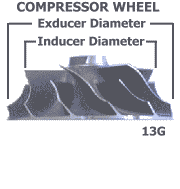
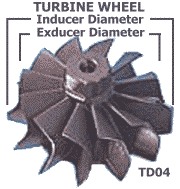
| Turbocharger Wheel-Size Comparison | |||||||||
|---|---|---|---|---|---|---|---|---|---|
| Turbo | Compressor | Turbine | |||||||
| Wheel | Inducer Diameter (in.) |
Exducer Diameter (in.) |
Trim | Housing | Wheel | Exducer Diameter (in.) |
Inducer Diameter (in.) |
Housing | |
| TD04-09B | 9B | 1.365 | 1.930 | 50 | TD04-09B | TD04 | 1.57 | 1.86 | TD04-6cm2 |
| TD04-13G | 13G | 1.580 | 2.000 | 62 | TD04-13G | TD04L | 1.62 | 1.86 | TD04L-6cm2 |
| GT347 | TE04H 13C | 1.580 | 2.087 | 57 | TD04-09B bored | TD04 | 1.57 | 1.86 | TD04-6cm2 |
| TD04-13T | 13T | 1.597 | 2.203 | 53 | TD04HL-13T | TD04HL | 1.80 | 2.05 | TD04-6cm2 |
| TD04-15G | 15G | 1.625 | 2.187 | 55 | TD04-13G bored | TD04L | 1.62 | 1.86 | TD04L-6cm2 |
| TD04H-15G | 15G | 1.625 | 2.187 | 55 | TD04H-15G | TD04H | 1.735 | 2.042 | TD04H-6cm2 |
| NA | Hitachi HT12 | 1.638 | 2.244 | 53 | TD04-09B bored | NA | NA | NA | NA |
| TD04H-15C | 15C | 1.654 | 2.187 | 57 | TD04H-15C | TD04H | 1.735 | 2.042 | TD04H-6cm2 |
| GT357 Magnum | T3 "50" Trim | 1.674 | 2.367 | 50 | TD04-13G bored | TE04H | 1.88 | 2.01 | TD04-6cm2 |
| TD05H-14B | 14B | 1.695 | 2.285 | 55 | TD05H-14B | TD05H | 1.93 | 2.20 | TD05H-6cm2 |
| TD04-16T | 16T | 1.713 | 2.205 | 60 | TD04HL-16T | TD04L | 1.62 | 1.86 | TD04L-6cm2 |
| TD04-18T | 18T | ? | ? | ? | TD04HL-18T | TD04L | 1.62 | 1.86 | TD04L-6cm2 |
| TD04-17G | 17G | 1.744 | 2.382 | 54 | TD04-13G bored | TD04L | 1.62 | 1.86 | TD04L-6cm2 |
| TD04-19T | 19T | 1.809 | 2.283 | 63 | TD04HL-19T | TD04L | 1.62 | 1.86 | TD04L-6cm2 |
| TD05H-14G | 14G | ~1.80 | 2.285 | ~62 | TD05H-14G | TD05H | 1.93 | 2.20 | TD05H-6cm2 |
| RHF5 | F5 | 1.812 | 2.375 | 58 | RHF5 | F5 | 1.875 | 2.065 | RHF5-6cm2 |
| RHF55 | F55 | 1.812 | 2.375 | 58 | RHF55 | F55 | 1.875 | 2.065 | RHF55-6cm2 |
| TD05H-16G "small" | 16G small | 1.830 | 2.365 | 60 | TD05H-16G | TD05H | 1.93 | 2.20 | TD05H-7cm2 |
| GT368SX | T3 "60" Trim | 1.830 | 2.367 | 60 | Garrett T3 | TE04H | 1.88 | 2.01 | TD04-6cm2 |
| Disco Potato | GT28RS | 1.860 | 2.362 | 62 | Garrett GT | NA | NA | NA | NA |
| TD05H-16G "large" | 16G large | 1.892 | 2.680 | 50 | TD05H-16G | TD05H | 1.93 | 2.20 | TD05H-7cm2 |
| TD05H-18A | 17C | 1.900 | 2.680 | 50 | TD05H-16G bored | TD05H | 1.93 | 2.20 | TD05H-8cm2 |
| TD05H-16G6 (Evo 3) | 16G6 | 1.902 | 2.680 | 50 | TD05H | TD05H | 1.93 | 2.20 | TD05H-7cm2 |
| ETA12 | TO4B S-Trim | 1.904 | 2.750 | 48 | Garrett | T3 | ? | ? | TD05H-7cm2 |
| GT35 48-trim 71-mm | custom GT35 | 1.936 | 2.795 | 48 | Garrett T04B | TD05H | 1.93 | 2.20 | TD05H-7cm2 |
| TD05H-18G | 18G | 1.992 | 2.680 | 55 | TD05H-18G | TD05H | 1.93 | 2.20 | TD05H-7cm2 |
| TD05H-20G | 20G | 2.070 | 2.680 | 60 | TD05H-17C | TD05H | 1.93 | 2.20 | TD05H-7cm2 |
| HKS GT2835 | custom GT35 | 2.092 | 2.795 | 56 | Garrett T04E | GT30R? trimmed |
2.016 | 2.224 | Garrett |
| GT35 52-trim 76-mm | GT35 | 2.158 | 2.992 | 52 | Garrett GT | NA | NA | NA | NA |
| GT42 56-Trim | GT42 | 2.769 | 3.700 | 56 | Garrett GT | NA | NA | NA | NA |
| GT42 53-Trim | GT42 | 2.924 | 4.016 | 53 | Garrett GT | NA | NA | NA | NA |
| MHI Turbine Wheels | ||||
|---|---|---|---|---|
| Wheel | Exducer (in.) | Inducer (in.) | Trim | Notes |
| TD04 | 1.57 | 1.86 | 71 | wheel height is less than the others |
| TD04L | 1.62 | 1.86 | 76 | |
| TD04H | 1.74 | 2.04 | 73 | |
| TD04HL | 1.80 | 2.05 | 77 | |
| TE04H | 1.88 | 2.01 | 87 | |
| TD05H | 1.93 | 2.20 | 77 | |
How to Select
So what can be done with all this information? You can determine the turbo that is appropriate for your car's use. First let me say that one group of turbos (say the TD05 for example) is not better than another group of turbos (say the TD04 or GT PRO hybrids). Each group, and each turbo, is optimized for certain applications. If possible, you should work with the manufacturer or vendor to be sure that a turbo's characteristics are optimized for your application.TD05H Kits
TD05 turbos are used on the DSM cars and so are fairly easy to find, modify, and rebuild. If you decide that a TD05-based turbo is the best model for your car, then you will have to either modify the turbo-mounting flange on the stock manifolds or use custom-built manifolds. Altered Atmosphere Motorsports (AAM) offers manifolds that use larger-diameter and equal-length runners to optimize flow for a real improvement over the stock manifolds. The AAM kit uses the "standard" TD05 turbos (like found on DSM cars) and use an integral wastegate, as do the stock TD04 turbos.| TD05H Exhaust Kits for the 3000GT/Stealth | ||
|---|---|---|
| Manufacturer | Price | Coments |
| GReddy | $2100 | - 3-bolt TD05H housing - external wastegate required |
| DN Performance | $2700 | - 3-bolt TD05H housing - internal wastegate - no pre-cat in rear exhaust fitting - IHI RH/RHF and TD04L turbos also bolt on - choice of material and finish |
| AAM | ? | - 4-bolt TD05H housing - internal wastegate - equal-length runners |
Compressor Flow Maps
On the compressor flow map, the horizontal axis represents the amount of uncompressed air entering one turbo, usually expressed in either cubic meters per second (0.1 m3/s = 211.888 cfm) or pounds per minute (10 lb/min = 144.718 cfm at 85.31ºF and 13.9487 psi). The vertical axis represents the amount of air compression that occurs inside the turbo; it is the ratio of the air pressure right after the turbo to the air pressure right before the turbo. The curved lines with labels such as 110000 are the rotational speed of the compressor wheel. The elliptical curves with labels such as 60% represent the efficiency of the compressor, or how well the compressor achieves pure adiabatic heating of the air (higher numbers are better and mean less extra heating of the air). The "raw" flow maps that I use here can be seen by clicking on the check marks in the table above. For a more complete explanation of compressor flow maps, please look at my web page 2-3s-compflowmaps.htm.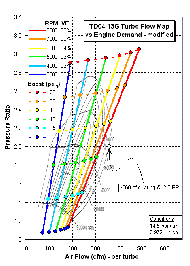 TD04H-13G (26 KB) |
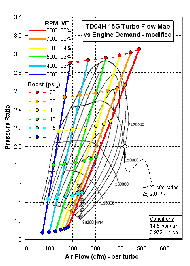 TD04H-15G (27 KB) |
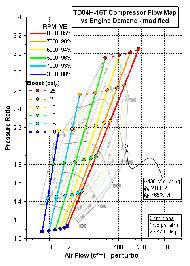 TD04H-16T (33 KB) |
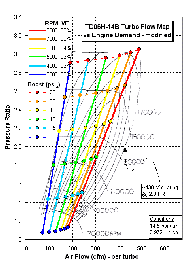 TD05H-14B (27 KB) |
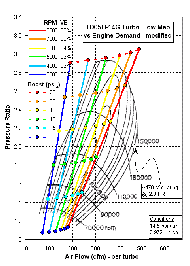 TD05H-14G (29 KB) |
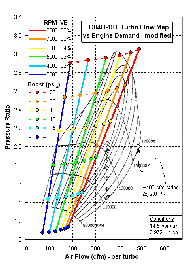 TD04H-18T (27 KB) |
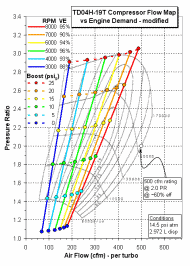 TD04H-19T (40 KB) |
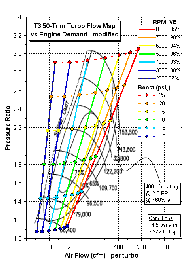 T3 50-Trim (28 KB) |
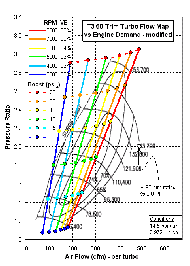 T3 60-Trim (27 KB) |
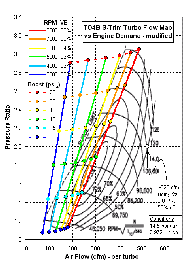 T04B S-Trim (32 KB) |
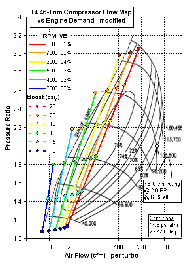 T4 46-trim (30 KB) |
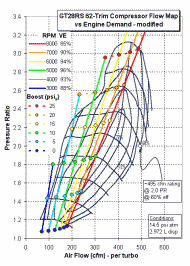 GT28RS 62-trim (29 KB) |
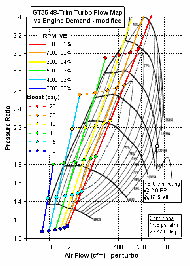 GT35 48-trim (32 KB) |
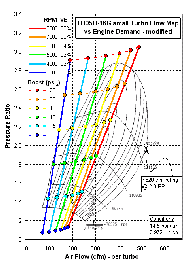 TD05H-16G-small (28 KB) |
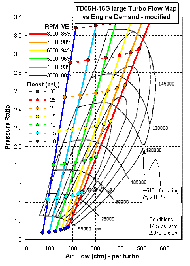 TD05H-16G-large (29 KB) |
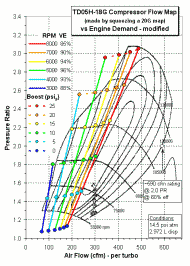 TD05H-18G (37 KB) |
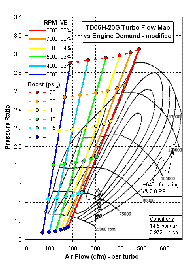 TD06H-20G (29 KB) |
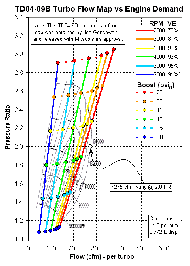 TD04-09B (23 KB) |
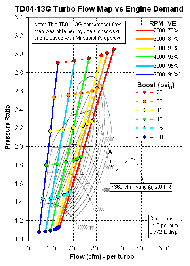 TD04-13G (26 KB) |
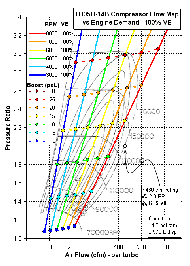 TD05H-14B (100% VE) (29 KB) |
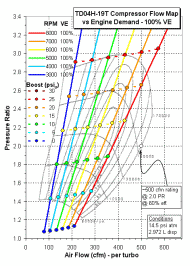 TD04H-19T (100% VE) (40 KB) |
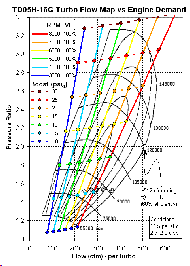 TD05H-16G (100% VE) (30 KB) |
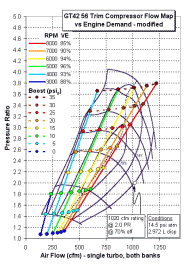 GT42 56-trim (30 KB) |
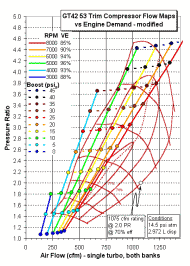 GT42 53-trim (33 KB) |
Where to Buy
Shop around and compare prices and services. For additional vendors, please visit my Links Page for sources of stock, rebuilt, and aftermarket turbos for our cars. Look in the following sections: "Speed Shops and Online Stores that specialize in our cars", "General Performance Products", "Specialty Products", and "Turbo-related".| Retail Vendors and Products | |
|---|---|
| Vendor | Products |
| Alamo Motorsports | TD04-13G/15G, TD05H-14G/16G |
| DN Performance | JUN manifolds and exhaust housings for IHI RHF55/RHF5, 3-bolt TD04L, and 3-bolt TD05H |
| DSM Performance |
Mutt, TD05H-16G |
| Extreme Motorsports | TD05H-16G/17C/19C/20G, Frank 1-6 |
| Extreme Turbo & Fabrication | remanufacture |
| Forced Performance | TD05H-16G/18G/20G RECOMMENDED FOR REBUILDS |
| Hahn Racecraft | TD04-13G, TD05H-16G |
| Mach V Motorsports | TD04-13G/15G |
| Majestic TurboChargers | remanufacture |
| MVP Motorsports | TD04-13G, GT-357 |
| Performance Techniques | remanufacture, repair, service, hybrids RECOMMENDED - REBUILDS, CUSTOM WORK |
| SL Turbo | TD04-18T |
| Team Rip Engineering | TD05H-16G/18G/20G, Frank 1- 6 |
| Texas Rebuild | remanufacture, repair kits, TD04-09B/13G/15G, TD05H-16G/17C/20G NOT RECOMMENDED |
| The Third Coast | TD04-13G/15G, GT-347/355/357/368/399 |
| Turbo City | remanufacture, repair kits |
| Turbo Engineering (TEC) | TD04-09B/13G/15G/17G RECOMMENDED FOR REBUILDS |
| Turbo Performance Center | HKS and Greddy turbos (TD04-13G) |
| Turbo Power | remanufacture, repair kits |
| Turbo Specialties | remanufacture, "true" TD04-15G (using TD04HL-15G wheels) |
Prices and Pictures
The table below shows some approximate prices or price ranges for pairs of various new turbos. Prices for rebuilt turbos may be less. Place your cursor above the camera icon to display a brief description of the picture then click on the icon to display the graphics file in a separate window.| Turbocharger Prices and Pictures | ||
|---|---|---|
| Turbo | Approximate Price for Two ($US) |
Pictures |
| TD04-09B | ~$2000 | |
| TD04-13G | $1500-2350 |
|
| TD04-15G | $1850-2700 | |
| TD04H-15G | $1950-2000 | |
| TD04-17G | $2732 | |
| TD04-18T | $2350 (with 9B core) | |
| GT368 | $3250 | |
| TD05-14B | $800+ | |
| TD05-14G | $1300 | |
| RHF55 | $3500 | |
| GReddy TD05 w/ manifolds, wastegates | $5100 | |
| TD05-16G "small" | $1200-1650 | |
| TD05-16G "large" | $1400-2000 | |
| Level 1 Mutt | $2800 | |
| TD05-20G | $1200-2450 | |
1/4-Mile Track Performance
Jack "xwing" Tertadian has used 9B, 13G, 15G, and 17G turbos on his cars and reports the following best 1/4-mile times and speeds. With stock TD04-9B turbos Jack ran a best of 12.727 s @ 107.562 mph in his 1993 VR4. Going to TD04-13G turbos, and no other changes, his performance improved to 12.172 s @ 112.890 mph (~16-17 psi boost). When he added the VPC setup and 550 cc/min injectors with the 13Gs, his best speed increased to 12.000 s @ 119.381 mph and his best time dropped to 11.702 s @ 118.061 mph. The TD04-15G turbos (and 20+ psi boost) with 550 cc/min injectors allowed Jack to run a best speed of 11.387 s @ 125.76 mph and best time of 11.303 @ 122.54 mph. Using 720 cc/min injectors with the 15G turbos did not improve Jack's track performance. Jack made these runs in a street car with full interior.|
----- Original Message ----- From: "xwing" To: stealth-3000gt@list.sirius.com Sent: Tuesday, October 26, 1999 12:35 AM Subject: 9B, 13G, 15G relative performances The 13G make at least 50+ hp more than the 9B. I did no other changes on my '93 and went from 12.727 @ 107.562 mph to 12.172 @ 112.890 mph quartermile on 8/31/94 going from 9B to 13G. This is somewhat over 50hp, and I did not have the VPC/550 injectors yet, so had to limit boost to ~16-17psi or fuelcut came in. In this configuration, went best of 114.350 mph on 9/27/94, ~65hp more (all stats are NO nitrous in this letter, except as noted). --I think 9B's can be good for about 410hp at wheels maxxed out with standard stuff. Once VPC/550 injectors in, 13G's went 12.000 and 119.381 best mph, on 4/8/95; about 500 hp at the wheels; overall, gained about 110 hp with 13G over 9B, but given other changes 13G likely ~100 hp better than 9B. 13G best ET was 11.702 @ 118.061 on 6/6/96; this was through traps in 3rd gear, on the rev limiter. I was the first 3000GT in the 11's 5/17/95 with an 11.937@118.338. --I think 13G can be good for about 510hp at wheels maxxed out with standard stuff. 15G best MPH was 11.387 @ 125.76 11/28/96 at the 1st Annual 3000GT/Stealth vs. Diamond Star Shootout in Temple, TX with the 550 injectors; about 575 hp at the wheels, so 15G make about 75 hp more than 13 G, but note I made some other changes so 15G likely ~40-50hp better than 13G. After that, 720cc injectors did not add any mph to trapspeed, indeed seemed to LOWER speed likely due to over-rich condition-- but lowered EGT a tad (max 1850 F at Temple) which may or may not have been good because knock could at random times mean EGT high due to retard, or due to a true lean mix. Best ET for me with 15G was 11.303 @ 122.54 at DSM Shootout 5/16/97, which I won class in :) full interior, as required by Dave Buschur...Adam Weltz went ~11.25 "no NOS". --I think 15G can be good for about 580hp at wheels maxxed out with standard stuff. My car made best 575 or so at wheels no NOS, but that is not "maxxed" because I always had stock intercoolers, no headers, no head/intake/throttlebody porting/ignition/standalone computer--with THOSE parts, my "maxxed out" figures could be somewhat higher... Best 3000GT/Stealth ET/MPH overall is still my 10.810 @ 128.44 with 15G's, 50hp NOS on 6/3/97; I had the distinct honor of making this pass lined up with the late Jeff Curtis in his Stealth... I'd not hesitate to get 13G's if desired and price right. The 15G make more topend, and I think they are worth it. 17G and more exotic turbos have yet to put better numbers to the pavement. When they do, we'll see what other mods/weight reductions etc are on the cars doing it. 15G are still unbeaten, both on motor and with NOS; are capable of 125 mph quartermile / 575+ hp AT THE WHEELS no NOS in my car, with only piggyback computer mods/no porting/enginework beyond the boltons. Pretty amazing, really. Jack Tertadian Atomic Motorsports :) |
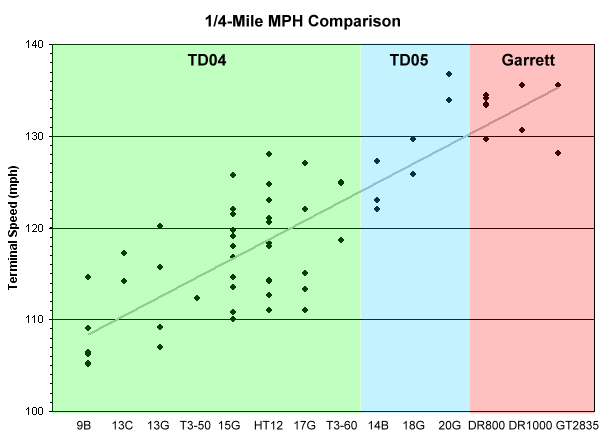
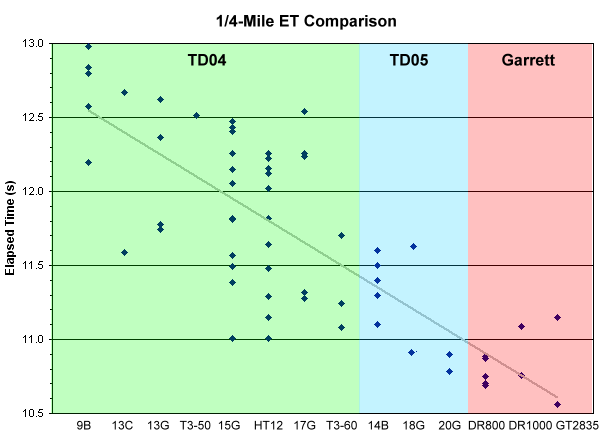
Acknowledgments
Some of the information presented here was gathered from various email lists, message boards, and vendor web sites. I would like to particularly thank Todd Shelton, Rob Beck, Giuseppe "Joe" Cannella (AAM), Errin Humphrey, Joe Gonsowski, Jack Tertadian, Kyle Edeker, Ray Pampena, Roger Gerl, Tom Stangl (http://www.vfaq.com/mods/Turbo-compare.html), Mikael Kenson, Bob Fontana, DSM Performance, Texas Rebuild, DN Performance, GT PRO Performance Tuning, Team Rip Engineering, Forced Performance, Road///Race Engineering, Garrett Turbochargers, Garrett Performance Products, Ray Hall Turbocharging, IHI Turbo America, Turbonetics, and Saito (MHI part numbers) for their contributions.| Back | Home | Forward |